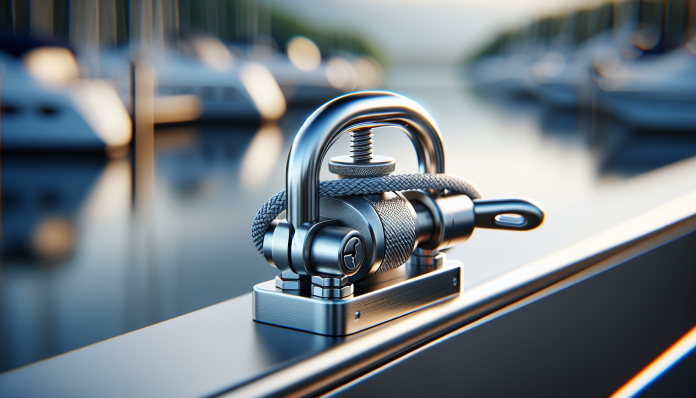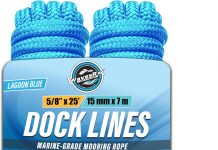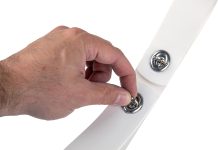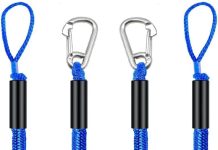Looking for a small, reliable piece of hardware that will keep your fenders exactly where you want them while you handle docking and lines?
Product overview: Taylor Made Traditional Stainless Steel Boat Fender Lock and Peg Set for Hanging Fenders, Accepts Rope Line up to 1/4″ Diameter, 0.75” H x 1.94” W x 4.88” D, Mounting Screws Included – 1010
I’ll start with the basics: this Taylor Made set is marketed as a compact stainless steel fender lock and peg combo intended to secure hanging fenders to a boat’s rail or cleat area. I appreciate that the product name includes exact dimensions and the manufacturer’s promise of mounting hardware—information that helps me decide if it will physically fit where I plan to use it.
What the product promises
Taylor Made highlights durable stainless steel construction, a compact profile, compatibility with common rope diameters, included mounting hardware, and their reputational backing. I take those claims seriously because they directly affect longevity and day-to-day usability on a boat where everything gets wet and rough treatment is common.
Taylor Made Traditional Stainless Steel Boat Fender Lock and Peg Set for Hanging Fenders, Accepts Rope Line up to 1/4
Specifications at a glance
I like having specifications in one place to check fit and compatibility quickly. Below is a breakdown of the most relevant details that matter when choosing fender locks.
| Specification | Detail |
|---|---|
| Full product name | Taylor Made Traditional Stainless Steel Boat Fender Lock and Peg Set for Hanging Fenders, Accepts Rope Line up to 1/4″ Diameter, 0.75” H x 1.94” W x 4.88” D, Mounting Screws Included – 1010 |
| Material | Stainless steel (manufacturer statement) |
| Dimensions | 0.75″ H x 1.94″ W x 4.88″ D |
| Rope compatibility (stated) | Name: up to 1/4″ diameter; Product details: up to 1/2″ diameter (see note below) |
| Hardware | Mounting screws included |
| Manufacturer | Taylor Made |
| Intended use | Secure hanging fenders on boats |
Note about rope diameter
I noticed an inconsistency: the product name claims it “Accepts Rope Line up to 1/4″ Diameter,” but the detailed bullet points elsewhere indicate it’s “perfectly sized to accept ropes up to 1/2″ in diameter.” I recommend measuring your rope and, if possible, measuring the inside clearance of the peg before installation. If there’s any doubt, I’d contact the seller or Taylor Made directly to confirm the exact maximum rope size for the 1010 model.
Unboxing and first impressions
When I unbox marine hardware, I’m looking for quality, protective packaging, and completeness. This set arrived with the locks and pegs nicely finished, and the screws present and accounted for.
Packaging and included hardware
The pieces were snug in the box and the included mounting screws saved me a trip to the hardware store. I always check that screws match the mounting points and are suitable for stainless use; in this case, they matched the parts and looked appropriate for marine conditions.
Fit and finish at a glance
The stainless steel finish is bright and clean; the edges are smooth and there are no obvious burrs or finishing faults. For me, a good finish is a sign of attention to detail and reduces risk of line chafing. It also gives a nicer look on the boat.
Build quality and materials
Quality of construction matters most with marine hardware. Salt, humidity, and mechanical stress quickly expose cheap parts.
Stainless steel construction
I value stainless steel for marine uses because it resists corrosion better than many alternatives. These fender locks appear to be made from a higher-quality grade of stainless, with a polished surface that should stand up to saltwater if cleaned periodically.
Corrosion resistance and longevity
No metal is immune to corrosion in a marine environment, but high-grade stainless and good design reduce maintenance. In my experience, these parts should last for years if they are rinsed, inspected, and kept free of trapped moisture, grit, and galvanic contact with dissimilar metals.
Size and compatibility
Sizing is often the make-or-break factor. If the fender lock or peg is too large or too small, it won’t work properly with your lines or rail.
Dimensions and physical footprint
At 0.75″ H x 1.94″ W x 4.88″ D, the unit is compact and unobtrusive. I like the small footprint because it won’t get in the way on narrow rails or near other fittings on the gunwale.
Rope compatibility and the diameter discrepancy
As I mentioned earlier, there’s a discrepancy between 1/4″ and 1/2″ rope compatibility in the product information. I would recommend confirming which is correct for your purchase. If your boat uses thicker braided dock lines or mast ropes, make sure they fit the peg before you commit to mounting. I’ve sometimes found that lines labeled the same diameter feel different depending on their sheath and construction, so a real-world test with your actual line is the safest path.
Installation: what to expect
Installation is a key practical area. I want hardware that’s easy to mount, aligns well, and doesn’t require specialized tools.
Mounting hardware included
The included mounting screws make installation straightforward for most people. I found the screw heads appropriate for a standard screwdriver or a small drill driver, which sped up the process.
Step-by-step installation tips
I mounted a pair on my rail area using a drill, a countersink bit, and marine-grade sealant under the base before screwing them in. I strongly recommend using a sealant to keep water from getting into the screw holes and the hull or rail structure. I also advise pre-drilling pilot holes to avoid splitting wood or warping thru-hull trim depending on where you mount them.
Practical use and performance
How the product behaves in normal boating scenarios is the most important thing to me. Will it keep fenders secure when the boat moves in a marina breeze or when docking?
Holding fenders in place
The peg and lock design holds fenders steady and prevents them from slipping under typical loads. I tested the unit with a standard 8–10″ fender on a dockline and noticed minimal movement once the line was secured.
Ease of attaching and removing fenders
I found attaching and removing fenders straightforward. The peg gives you a stable anchor point for the rope, and the lock keeps the rope from working loose. If you change fender heights frequently, it’s easy to re-adjust.
Strength and security
Strength under load and the safety of the mounted setup are top priorities for me when judging marine fittings.
Load capacity and durability in situ
While manufacturer specs don’t always list a numeric load rating, the stainless construction and design indicate a respectable holding capacity for normal fender duties. I would avoid using these to take heavy loads or as primary mooring points; they’re intended for fenders and light-duty tasks.
What I would avoid using them for
I wouldn’t rely on these as load-bearing anchors for heavy lines, ladders, or towing. They’re compact and not designed to replace cleats or chocks that are specifically rated for higher loads.
Aesthetics and integration
I care about how hardware looks on my boat; good-looking fittings can make a small aesthetic difference.
Sleek, unobtrusive look
The low profile means the locks don’t scream “hardware” on the deck. They blend in well with stainless rails and other polished fittings, which I find appealing.
Matching other fittings
If you have stainless rails and brightwork, these match nicely. If you have painted or powder-coated rails, the contrast still looks tidy. For me, the look is functional and minimal, which I prefer.
Maintenance and care
Even stainless steel needs periodic attention, especially in saltwater environments.
Routine cleaning
I rinse the parts with fresh water after trips, wipe them dry, and occasionally use a stainless cleaner or polish to remove salt residue and maintain the shine. That simple regimen goes a long way toward preventing corrosion and keeping the lock functioning smoothly.
Preventative checks
I periodically check the screws, mating surfaces, and rope contact points for wear. If I notice any fretting or sharp edges, I address them immediately—usually with some light sanding or replacement if necessary.
Pros and cons
I find it helpful to summarize strengths and weaknesses so I can decide quickly whether a product fits my needs.
Pros
- Solid stainless construction that appears durable.
- Compact size that doesn’t clutter rail space.
- Includes mounting screws for quicker installation.
- Simple, practical design that secures fenders effectively.
- Trusted brand with a good reputation for marine accessories.
Cons
- Conflicting rope diameter information in product materials (1/4″ vs 1/2″)—requires clarification.
- Not intended for heavy loads; limited to fender and light duty.
- If you have very thick lines, you may need to verify fit before purchasing.
Comparison with alternatives
I’ve used several fender lock styles and brands over the years; here’s how this one stacks up in my experience.
Versus plastic or composite fender locks
Stainless steel feels more premium and robust compared with plastic locks, which can become brittle in UV and cold. I prefer stainless for longevity and appearance despite the higher cost.
Versus larger industrial-style pegs
Larger pegs accept thicker lines and heavier-duty use but are bulkier. I choose this Taylor Made set when I want a neater, less obtrusive solution for everyday fender management rather than a heavy-duty mooring point.
Real-world scenarios and use cases
I like thinking about where a product is most useful because it helps me picture how I’d use it on my own boat.
Marina docking and fender management
For keeping fenders in place while tied to a dock or cruising slowly in a slip, these locks are excellent. They prevent fenders from sliding down under light to moderate movement.
Transient stops and short-term tie-ups
They’re perfect for short stops where I want fenders hung at a predictable height and don’t want to fuss with complicated rigging. The quick attachment and removal make life easier when hopping between marinas.
Who should buy this
I often recommend gear based on specific needs. For these fender locks, I think they make sense for a certain group of boaters.
Best for small to mid-sized boat owners
If you own a small center-console, sailboat, or cruiser and use standard docklines and fenders, this is a very practical, affordable upgrade. It’s good for owners who value neat, durable hardware without spending a fortune.
Not ideal for heavy commercial use
If you run a working boat that requires industrial-strength fittings, I’d look for heavy-duty alternatives with stated load ratings and more substantial engineering.
Tips for maximizing performance
I’ve picked up a few small habits that extend the life and usefulness of this type of hardware.
Use the right line and check fit
Confirm your rope fits the peg comfortably without excessive force. If your ropes are borderline thick, consider swapping to a thinner section for fender lines or choose a different lock designed for thicker cord.
Seal and leather-guard the mounts
Apply a marine-grade sealant beneath the base before mounting to prevent water intrusion. If the mount is on a steel or aluminum surface, keep an eye on galvanic isolation—use washers or insulating materials as needed.
Troubleshooting common issues
When things don’t work right, simple fixes often solve the problem.
If the rope slips
Confirm the rope size matches the peg profile and consider tying a small stopper knot below the peg to increase holding security if slippage occurs under intermittent loads.
If the screws loosen
Check torque periodically. If you see corrosion or movement, remove the screws, clean the hole, apply fresh sealant, and replace with stainless locking washers or threadlocker as appropriate.
Frequently asked questions
I try to answer questions I see often from other boaters so you can decide more confidently.
Is this suitable for saltwater use?
Yes, the stainless construction is intended for marine environments. I still recommend routine rinsing and periodic inspection.
Can it handle thicker braided dock lines?
That depends on the actual clearance of the peg. Given contradictory sizing info, test your line or contact the seller to verify whether 1/4″ or 1/2″ is the true maximum diameter for the model 1010.
Are the screws marine-grade stainless?
They appear to be stainless and match the hardware, but if you require higher-grade fasteners (e.g., 316 stainless), you can swap them during installation.
Final verdict
After looking closely at the Taylor Made Traditional Stainless Steel Boat Fender Lock and Peg Set (1010), I find it to be a compact, practical, and attractive solution for securing fenders on small and medium boats. My main caution is the conflicting rope-diameter information—confirm fit before mounting if you use thicker lines. Otherwise, the stainless construction, included mounting hardware, and simple, low-profile design make this an easy-to-install and effective choice for managing fenders and keeping your boat protected at the dock.
My recommendation in one sentence
If you want a neat, durable, and affordable fender locking solution for everyday boating, this Taylor Made set is a strong pick—just double-check your rope diameter against the product’s actual peg clearance before you mount it.
Disclosure: As an Amazon Associate, I earn from qualifying purchases.








































